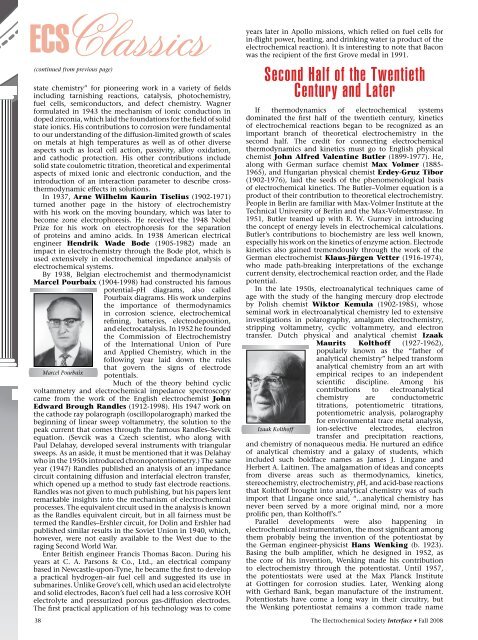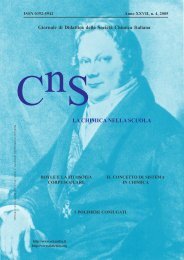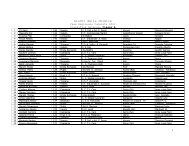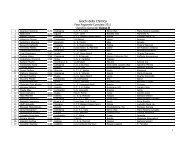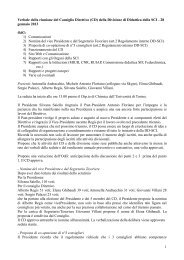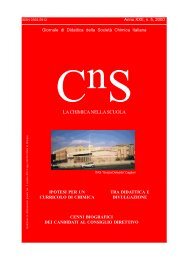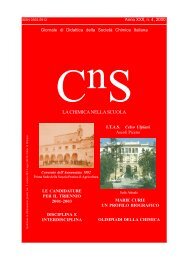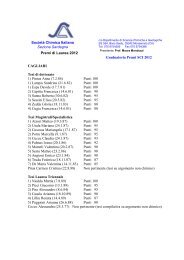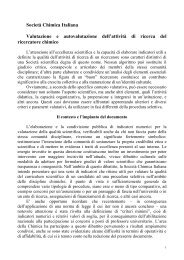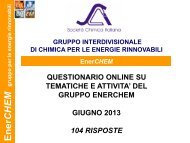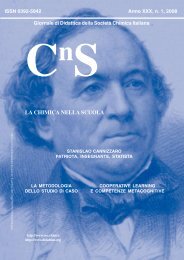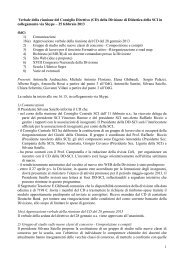ECS Classics - The Electrochemical Society
ECS Classics - The Electrochemical Society
ECS Classics - The Electrochemical Society
You also want an ePaper? Increase the reach of your titles
YUMPU automatically turns print PDFs into web optimized ePapers that Google loves.
<strong>ECS</strong> <strong>Classics</strong><br />
(continued from previous page)<br />
state chemistry” for pioneering work in a variety of fields<br />
including tarnishing reactions, catalysis, photochemistry,<br />
fuel cells, semiconductors, and defect chemistry. Wagner<br />
formulated in 1943 the mechanism of ionic conduction in<br />
doped zirconia, which laid the foundations for the field of solid<br />
state ionics. His contributions to corrosion were fundamental<br />
to our understanding of the diffusion-limited growth of scales<br />
on metals at high temperatures as well as of other diverse<br />
aspects such as local cell action, passivity, alloy oxidation,<br />
and cathodic protection. His other contributions include<br />
solid state coulometric titration, theoretical and experimental<br />
aspects of mixed ionic and electronic conduction, and the<br />
introduction of an interaction parameter to describe crossthermodynamic<br />
effects in solutions.<br />
In 1937, Arne Wilhelm Kaurin Tiselius (1902-1971)<br />
turned another page in the history of electrochemistry<br />
with his work on the moving boundary, which was later to<br />
become zone electrophoresis. He received the 1948 Nobel<br />
Prize for his work on electrophoresis for the separation<br />
of proteins and amino acids. In 1938 American electrical<br />
engineer Hendrik Wade Bode (1905-1982) made an<br />
impact in electrochemistry through the Bode plot, which is<br />
used extensively in electrochemical impedance analysis of<br />
electrochemical systems.<br />
By 1938, Belgian electrochemist and thermodynamicist<br />
Marcel Pourbaix (1904-1998) had constructed his famous<br />
potential–pH diagrams, also called<br />
Pourbaix diagrams. His work underpins<br />
the importance of thermodynamics<br />
in corrosion science, electrochemical<br />
refining, batteries, electrodeposition,<br />
and electrocatalysis. In 1952 he founded<br />
the Commission of Electrochemistry<br />
of the International Union of Pure<br />
and Applied Chemistry, which in the<br />
following year laid down the rules<br />
Marcel Pourbaix<br />
that govern the signs of electrode<br />
potentials.<br />
Much of the theory behind cyclic<br />
voltammetry and electrochemical impedance spectroscopy<br />
came from the work of the English electrochemist John<br />
Edward Brough Randles (1912-1998). His 1947 work on<br />
the cathode ray polarograph (oscillopolarograph) marked the<br />
beginning of linear sweep voltammetry, the solution to the<br />
peak current that comes through the famous Randles–Sevcik<br />
equation. (Sevcik was a Czech scientist, who along with<br />
Paul Delahay, developed several instruments with triangular<br />
sweeps. As an aside, it must be mentioned that it was Delahay<br />
who in the 1950s introduced chronopotentiometry.) <strong>The</strong> same<br />
year (1947) Randles published an analysis of an impedance<br />
circuit containing diffusion and interfacial electron transfer,<br />
which opened up a method to study fast electrode reactions.<br />
Randles was not given to much publishing, but his papers lent<br />
remarkable insights into the mechanism of electrochemical<br />
processes. <strong>The</strong> equivalent circuit used in the analysis is known<br />
as the Randles equivalent circuit, but in all fairness must be<br />
termed the Randles–Ershler circuit, for Dolin and Ershler had<br />
published similar results in the Soviet Union in 1940, which,<br />
however, were not easily available to the West due to the<br />
raging Second World War.<br />
Enter British engineer Francis Thomas Bacon. During his<br />
years at C. A. Parsons & Co., Ltd., an electrical company<br />
based in Newcastle-upon-Tyne, he became the first to develop<br />
a practical hydrogen–air fuel cell and suggested its use in<br />
submarines. Unlike Grove’s cell, which used an acid electrolyte<br />
and solid electrodes, Bacon’s fuel cell had a less corrosive KOH<br />
electrolyte and pressurized porous gas-diffusion electrodes.<br />
<strong>The</strong> first practical application of his technology was to come<br />
years later in Apollo missions, which relied on fuel cells for<br />
in-flight power, heating, and drinking water (a product of the<br />
electrochemical reaction). It is interesting to note that Bacon<br />
was the recipient of the first Grove medal in 1991.<br />
Second Half of the Twentieth<br />
Century and Later<br />
If thermodynamics of electrochemical systems<br />
dominated the first half of the twentieth century, kinetics<br />
of electrochemical reactions began to be recognized as an<br />
important branch of theoretical electrochemistry in the<br />
second half. <strong>The</strong> credit for connecting electrochemical<br />
thermodynamics and kinetics must go to English physical<br />
chemist John Alfred Valentine Butler (1899-1977). He,<br />
along with German surface chemist Max Volmer (1885-<br />
1965), and Hungarian physical chemist Erdey-Gruz Tibor<br />
(1902-1976), laid the seeds of the phenomenological basis<br />
of electrochemical kinetics. <strong>The</strong> Butler–Volmer equation is a<br />
product of their contribution to theoretical electrochemistry.<br />
People in Berlin are familiar with Max-Volmer Institute at the<br />
Technical University of Berlin and the Max-Volmerstrasse. In<br />
1951, Butler teamed up with R. W. Gurney in introducing<br />
the concept of energy levels in electrochemical calculations.<br />
Butler’s contributions to biochemistry are less well known,<br />
especially his work on the kinetics of enzyme action. Electrode<br />
kinetics also gained tremendously through the work of the<br />
German electrochemist Klaus-Jürgen Vetter (1916-1974),<br />
who made path-breaking interpretations of the exchange<br />
current density, electrochemical reaction order, and the Flade<br />
potential.<br />
In the late 1950s, electroanalytical techniques came of<br />
age with the study of the hanging mercury drop electrode<br />
by Polish chemist Wiktor Kemula (1902-1985), whose<br />
seminal work in electroanalytical chemistry led to extensive<br />
investigations in polarography, amalgam electrochemistry,<br />
stripping voltammetry, cyclic voltammetry, and electron<br />
transfer. Dutch physical and analytical chemist Izaak<br />
Maurits Kolthoff (1927-1962),<br />
popularly known as the “father of<br />
analytical chemistry” helped transform<br />
analytical chemistry from an art with<br />
empirical recipes to an independent<br />
scientific discipline. Among his<br />
contributions to electroanalytical<br />
chemistry are conductometric<br />
titrations, potentiometric titrations,<br />
potentiometric analysis, polarography<br />
Izaak Kolthoff<br />
for environmental trace metal analysis,<br />
ion-selective electrodes, electron<br />
transfer and precipitation reactions,<br />
and chemistry of nonaqueous media. He nurtured an edifice<br />
of analytical chemistry and a galaxy of students, which<br />
included such boldface names as James J. Lingane and<br />
Herbert A. Laitinen. <strong>The</strong> amalgamation of ideas and concepts<br />
from diverse areas such as thermodynamics, kinetics,<br />
stereochemistry, electrochemistry, pH, and acid-base reactions<br />
that Kolthoff brought into analytical chemistry was of such<br />
import that Lingane once said, “...analytical chemistry has<br />
never been served by a more original mind, nor a more<br />
prolific pen, than Kolthoff’s.”<br />
Parallel developments were also happening in<br />
electrochemical instrumentation, the most significant among<br />
them probably being the invention of the potentiostat by<br />
the German engineer-physicist Hans Wenking (b. 1923).<br />
Basing the bulb amplifier, which he designed in 1952, as<br />
the core of his invention, Wenking made his contribution<br />
to electrochemistry through the potentiostat. Until 1957,<br />
the potentiostats were used at the Max Planck Institute<br />
at Gottingen for corrosion studies. Later, Wenking along<br />
with Gerhard Bank, began manufacture of the instrument.<br />
Potentiostats have come a long way in their circuitry, but<br />
the Wenking potentiostat remains a common trade name<br />
38 <strong>The</strong> <strong>Electrochemical</strong> <strong>Society</strong> Interface • Fall 2008


